Insights - Autonomous Supply Chains: The Next Frontier in Logistics
Autonomous Supply Chains
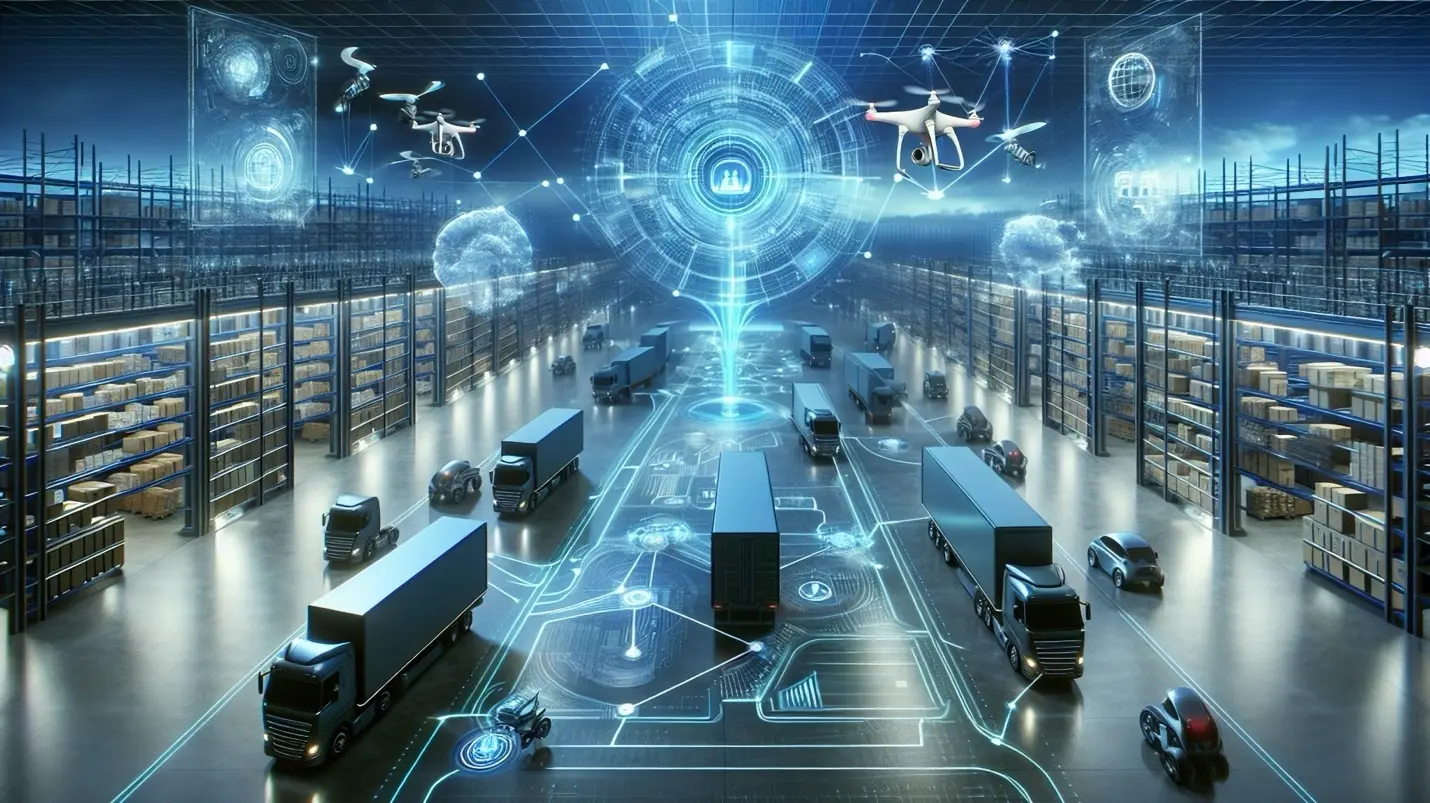
A. Introduction: The Age of Autonomous Logistics
In the face of increasing global challenges, modern supply chains have reached a pivotal crossroads. Recent disruptions, from the COVID-19 pandemic to geopolitical conflicts and extreme weather events, have exposed the fragility of traditional supply chain models. Companies have scrambled to adapt, relying on outdated systems that struggle to provide the agility, efficiency, and resilience needed to navigate today’s complexities. Against this backdrop, a new frontier has emerged, autonomous supply chains, powered by advanced technologies such as artificial intelligence (AI), the Internet of Things (IoT), and robotics.
Imagine a warehouse where robotic systems seamlessly coordinate to pick, pack, and ship products, guided by real-time data from IoT sensors. Picture fleets of delivery drones and autonomous vehicles navigating city streets with precision, while AI-powered algorithms optimize routes to avoid delays. These are not visions of the distant future, they are happening now, reshaping the logistics landscape in profound ways.
Autonomous supply chains offer a paradigm shift, enabling businesses to operate smarter, faster, and more cost-effectively. By leveraging interconnected systems, predictive analytics, and self-optimizing technologies, organizations can anticipate disruptions, streamline operations, and reduce waste. This transformation extends beyond efficiency; it addresses critical global issues such as sustainability and resource optimization.
During the pandemic, companies like Amazon leveraged autonomous systems to sustain operations despite labor shortages and unprecedented demand surges. Warehouse robotics played a crucial role in maintaining fulfillment speed, while predictive analytics ensured inventory levels matched shifting consumer behaviors. Similarly, DHL has piloted autonomous drones for last-mile delivery, significantly reducing delivery times in rural and hard-to-reach areas. These early adopters illustrate the immense potential of autonomous supply chains in overcoming logistical bottlenecks and redefining industry standards.
However, this innovation is not without its challenges. The integration of advanced technologies requires significant investments in infrastructure, cybersecurity, and workforce training. As businesses embark on this journey, they must address critical questions: How can they ensure data integrity and interoperability across systems? What measures will safeguard against cyberattacks on connected networks? And how can they balance automation with the human expertise that remains vital to decision-making?
The rise of autonomous supply chains is more than a technological revolution; it represents a strategic imperative for businesses seeking to thrive in an increasingly volatile and competitive world. By embracing these advancements, companies can position themselves as leaders in a rapidly evolving logistics ecosystem, meeting the demands of tomorrow’s customers while mitigating risks.
As we explore the intricacies of autonomous supply chains in the sections ahead, we will examine how AI, IoT, and robotics are transforming logistics, delve into real-world case studies from industry pioneers, address the challenges of implementation, and look ahead to the future of this transformative innovation.
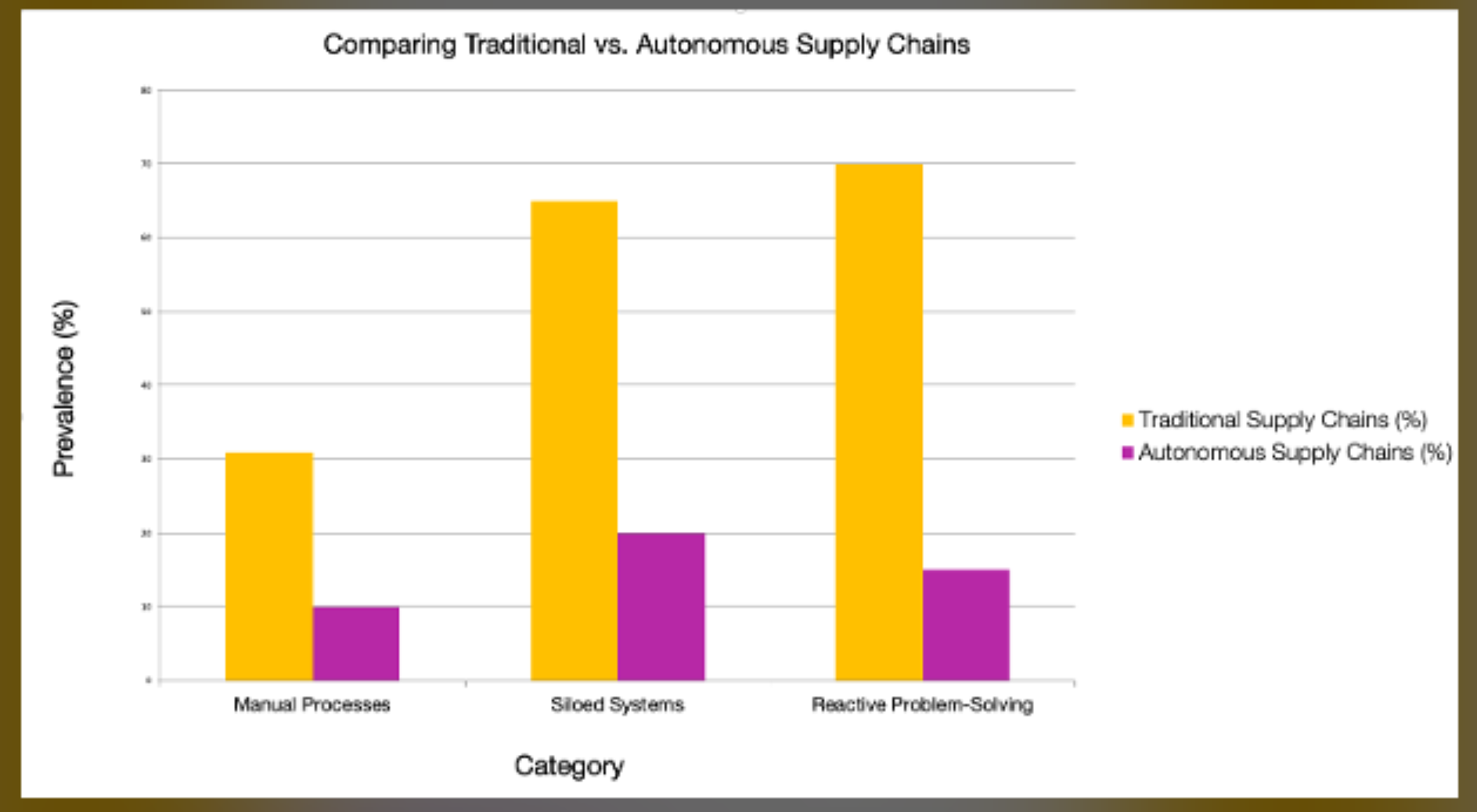
B. What Are Autonomous Supply Chains?
The global logistics landscape is evolving rapidly, and at the heart of this transformation lies the concept of autonomous supply chains. Building on the challenges outlined in the introduction, autonomous supply chains represent the next stage in operational innovation—a shift from traditional, reactive systems to proactive, self-optimizing networks.
At its core, an autonomous supply chain leverages advanced technologies such as artificial intelligence (AI), machine learning (ML), the Internet of Things (IoT), and robotics to minimize human intervention in decision-making and execution. These systems are designed to sense, analyze, and act on real-time data to ensure continuous optimization. By creating a seamless flow of information and automating repetitive tasks, businesses can reduce costs, improve efficiency, and increase resilience against disruptions.
For instance, IoT sensors embedded in shipments or warehouse equipment nowadays have the capability to continuously collect and transmit data, such as temperature, humidity, location, and movement. This real-time feedback feeds into AI-driven systems, which analyze the information to make immediate adjustments. If a delay is detected in a shipment route, the system might automatically reroute the delivery to avoid bottlenecks, ensuring on-time performance. Similarly, AI-powered demand forecasting can predict when inventory levels are running low, triggering automated restocking before a shortage occurs.
The Three Pillars of Autonomous Supply Chains
- Artificial Intelligence and Machine Learning
Artificial intelligence (AI) drives predictive analytics by analyzing vast datasets to identify patterns and trends that allow businesses to anticipate disruptions before they occur. This includes forecasting weather events, transportation delays, or shifts in consumer demand. Machine learning, a subset of AI, plays a critical role in this process by enabling systems to learn from historical data and continuously refine their predictions. Unlike static rule-based models, machine learning algorithms adapt over time, improving accuracy and reliability as they process more data.
- Example: A global retail chain might use AI-driven predictive analytics, powered by machine learning, to forecast demand spikes during holiday seasons. This ensures warehouses are pre-stocked with high-demand items, reducing lead times and avoiding missed sales opportunities.
- Internet of Things (IoT)
IoT acts as the nervous system of an autonomous supply chain, providing the data necessary for real-time decision-making. IoT-enabled devices—ranging from GPS trackers on trucks to smart shelves in warehouses—capture and transmit data across the supply chain. This connectivity allows businesses to monitor operations remotely and identify inefficiencies or risks as they arise.
- Example: A pharmaceutical company uses IoT sensors to monitor the temperature of vaccines in transit, ensuring compliance with strict cold-chain requirements. If a temperature fluctuation is detected, the system triggers an alert, allowing immediate corrective action to prevent spoilage.
- Robotics and Automation
Automation, powered by robotics, is the engine driving many autonomous supply chain processes. From autonomous forklifts and robotic picking systems in warehouses to drones and self-driving trucks for delivery, robotics eliminate inefficiencies and reduce human dependency in logistics.
- Example: In large e-commerce fulfillment centers, robotic arms collaborate with humans to pick and pack items faster and more accurately than manual processes alone. Companies like Amazon have already demonstrated how these technologies can reduce order processing times and improve overall productivity.
The Distinction: Autonomous vs. Traditional Supply Chains
Traditional supply chains are often characterized by manual processes, siloed operations, and reactive problem-solving. Decision-making is centralized and heavily reliant on human intervention, which slows response times and increases costs. In contrast, autonomous supply chains are dynamic, decentralized, and data-driven. They respond in real time to changing conditions, leveraging automation and connectivity to achieve end-to-end visibility and control.
In a traditional model, a delayed shipment might require a supply chain manager to manually identify the issue, coordinate with multiple stakeholders, and implement a solution, often resulting in delays and added costs. In an autonomous system, IoT sensors would immediately detect the delay, AI algorithms would identify alternative routes, and automated notifications would inform downstream stakeholders of the revised timeline, all without human intervention.
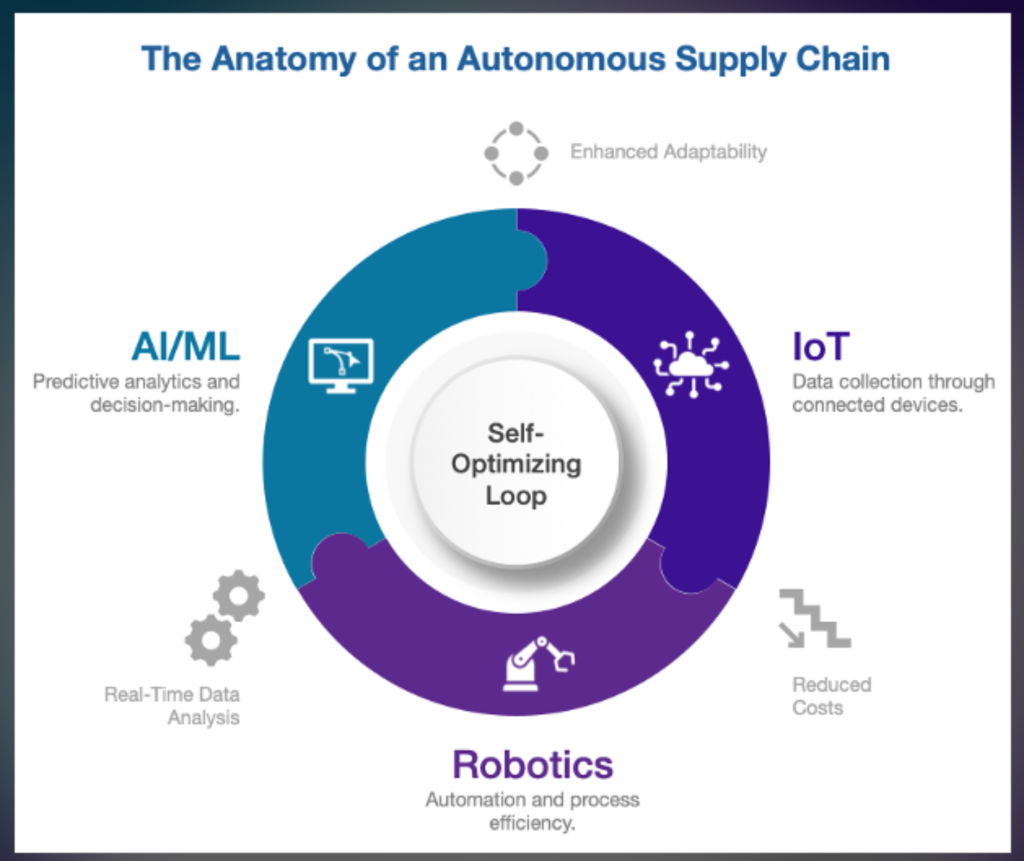
Autonomous supply chains represent more than a technological leap; they embody a philosophical shift in how businesses approach logistics and decision-making. By combining AI, IoT, and robotics, these systems redefine efficiency and adaptability, ensuring supply chains are not just operationally optimized but future-proof.
C. Real-World Examples of Autonomous Supply Chains
The transformative potential of autonomous supply chains is no longer hypothetical, it is being realized today by forward-thinking companies across industries. Global leaders such as Amazon, DHL, and Walmart are leveraging cutting-edge technologies to redefine logistics and set new standards for efficiency, adaptability, and customer satisfaction. These real-world examples provide a glimpse into how autonomous supply chains are reshaping the business landscape.
Amazon: Redefining Warehouse Operations
Amazon is widely recognized as a pioneer in supply chain innovation, with its fulfillment centers serving as prime examples of autonomous logistics. The company’s integration of robotics and AI-driven systems has transformed warehouse operations into highly efficient, automated environments.
- Robotic Systems in Warehouses: Since acquiring Kiva Systems in 2012 (now Amazon Robotics), Amazon has deployed over 500,000 robotic systems globally. These robots navigate warehouse floors, transporting shelves of products to human workers for picking and packing. This system eliminates the need for workers to walk across vast warehouses, significantly reducing processing times and labor costs.
- Example: During peak seasons such as Black Friday, Amazon’s robotic systems enable fulfillment centers to process millions of orders seamlessly, maintaining high customer satisfaction rates.
- Predictive Analytics for Inventory Management: Amazon’s AI algorithms analyze consumer behavior and historical sales data to predict demand spikes and optimize inventory placement. Items expected to sell quickly in specific regions are pre-stocked in nearby fulfillment centers, enabling faster delivery times and minimizing logistical costs.
DHL: Innovating Last-Mile Delivery
DHL has established itself as a trailblazer in logistics by integrating autonomous technologies across its supply chain. Its initiatives span predictive analytics, drones, and robotics, illustrating the diverse applications of autonomy in logistics.
- Predictive Supply Chain Analytics: DHL’s “Resilience360” platform employs AI to monitor supply chain risks in real time. By analyzing data from weather reports, geopolitical updates, and transportation schedules, the platform predicts potential disruptions and recommends alternative routes or strategies.
- Example: During a recent hurricane in the United States, DHL’s predictive system rerouted shipments to avoid affected regions, ensuring on-time delivery, and minimizing losses.
- Example: During a recent hurricane in the United States, DHL’s predictive system rerouted shipments to avoid affected regions, ensuring on-time delivery, and minimizing losses.
- Autonomous Drones for Delivery: DHL’s Parcelcopter program, piloted in remote areas of Germany, uses drones to deliver packages to hard-to-reach locations. These drones significantly reduce delivery times while cutting costs associated with traditional transportation.
- Example: In Bavarian mountain regions, drones have delivered medical supplies and other critical items in under 30 minutes—a fraction of the time required by ground transportation.
Walmart: Enhancing Visibility and Sustainability
Walmart, has embraced autonomy to enhance operational transparency and sustainability within its supply chain.
- IoT-Enabled Shipment Tracking: Walmart employs IoT sensors to monitor shipments in real time, providing full visibility into location, temperature, and handling conditions. This technology is particularly crucial for perishable goods, where small delays can lead to spoilage.
- Example: During the COVID-19 pandemic, Walmart used IoT systems to manage vaccine distribution, ensuring cold-chain compliance and timely delivery.
- Example: During the COVID-19 pandemic, Walmart used IoT systems to manage vaccine distribution, ensuring cold-chain compliance and timely delivery.
- Blockchain for Food Traceability: Walmart has also implemented blockchain technology to track food products from farm to shelf. This system allows the company to quickly trace the origin of contaminated items, reducing the time required for recalls from days to mere seconds.
- Example: In partnership with IBM, Walmart’s blockchain initiative has improved transparency and trust within its supply chain, benefiting both consumers and suppliers.
The innovations showcased by Amazon, DHL, and Walmart illustrate the immense potential of autonomous supply chains in transforming logistics. These systems are delivering measurable benefits, faster deliveries, enhanced visibility, and greater sustainability. However, the path to achieving autonomy is not without its hurdles. Businesses must navigate a host of challenges, from data integration to cybersecurity risks, as they adopt these advanced technologies.
D. Challenges in Implementing Autonomous Supply Chains
While the promise of autonomous supply chains is compelling, the journey toward full implementation is fraught with challenges. Transitioning from traditional supply chain models to autonomous systems requires businesses to navigate complex technological, organizational, and operational barriers. These challenges are not insurmountable but demand a strategic, well-planned approach to ensure successful adoption.
- Data Integration Across Fragmented Systems
One of the most significant obstacles to implementing autonomous supply chains is the integration of data from disparate sources. Supply chains often involve multiple stakeholders, including suppliers, manufacturers, distributors, and retailers, each operating with different systems and standards. Consolidating this fragmented data into a unified platform is a daunting task.
- Example: A multinational electronics manufacturer may rely on hundreds of suppliers spread across the globe, each using its own enterprise resource planning (ERP) or inventory management software. To create a seamless, autonomous system, the company must establish data-sharing protocols and integrate these systems into a centralized AI-powered platform.
- Challenges: Legacy systems, incompatible software, and resistance from partners unwilling to share proprietary data exacerbate the problem.
- Potential Solutions: Cloud-based platforms and middleware tools, such as SAP Integrated Business Planning or Oracle Supply Chain Management Cloud, can bridge the gap by enabling real-time data exchange.
- Example: A multinational electronics manufacturer may rely on hundreds of suppliers spread across the globe, each using its own enterprise resource planning (ERP) or inventory management software. To create a seamless, autonomous system, the company must establish data-sharing protocols and integrate these systems into a centralized AI-powered platform.
- Cybersecurity Risks in Connected Networks
The interconnected nature of autonomous supply chains makes them vulnerable to cyberattacks. As IoT devices, AI systems, and robotics become more prevalent, they increase the number of potential entry points for malicious actors. A successful attack could disrupt operations, compromise sensitive data, or even halt the entire supply chain.
- Example: In 2020, a ransomware attack targeted a major global logistics provider, causing widespread delays in shipping and costing millions of dollars in lost revenue. Such incidents highlight the critical importance of securing autonomous systems against cyber threats.
- Challenges: Many companies lack robust cybersecurity measures tailored to IoT devices and AI-driven platforms, leaving them exposed to risks.
- Potential Solutions: Businesses must adopt a multi-layered cybersecurity approach, including encryption, continuous monitoring, and intrusion detection systems (IDS). Collaboration with cybersecurity experts, such as Palo Alto Networks or Symantec, can provide tailored solutions for supply chain security.
- Example: In 2020, a ransomware attack targeted a major global logistics provider, causing widespread delays in shipping and costing millions of dollars in lost revenue. Such incidents highlight the critical importance of securing autonomous systems against cyber threats.
- Ensuring Real-Time Visibility and Transparency
Achieving real-time visibility across the entire supply chain is both a goal and a challenge. Autonomous systems rely on accurate, up-to-date data to make informed decisions, but disruptions such as inaccurate sensor readings, network latency, or incomplete data streams can hinder transparency.
- Example: During the Suez Canal blockage in 2021, many companies with limited visibility into their supply chains struggled to reroute shipments efficiently. Real-time tracking and predictive analytics could have mitigated these delays.
- Challenges: Establishing end-to-end visibility requires substantial investments in IoT devices, connectivity infrastructure, and analytics software. Additionally, human oversight is still necessary to validate the accuracy of automated insights.
- Potential Solutions: The use of blockchain technology for supply chain tracking can enhance transparency and trust. For example, IBM’s blockchain-based Food Trust platform has shown how end-to-end visibility can benefit industries like agriculture and food production.
- Example: During the Suez Canal blockage in 2021, many companies with limited visibility into their supply chains struggled to reroute shipments efficiently. Real-time tracking and predictive analytics could have mitigated these delays.
- Workforce Transformation and Skill Gaps
The adoption of autonomous supply chains introduces significant changes to workforce dynamics. While automation reduces the need for manual labor in repetitive tasks, it increases demand for skilled workers who can manage, maintain, and optimize advanced systems. This shift requires retraining existing employees and attracting new talent with specialized expertise.
- Example: In Amazon’s robotic warehouses, employees have transitioned from physically handling goods to overseeing and troubleshooting robotic systems. While this shift has improved operational efficiency, it has also created a need for ongoing training programs to upskill the workforce.
- Challenges: Resistance to change, lack of training resources, and the high cost of hiring skilled professionals can delay the adoption of autonomous systems.
- Potential Solutions: Companies can partner with educational institutions to develop training programs focused on AI, IoT, and robotics. Additionally, government incentives for workforce development in automation-related fields can help ease the financial burden.
- Example: In Amazon’s robotic warehouses, employees have transitioned from physically handling goods to overseeing and troubleshooting robotic systems. While this shift has improved operational efficiency, it has also created a need for ongoing training programs to upskill the workforce.
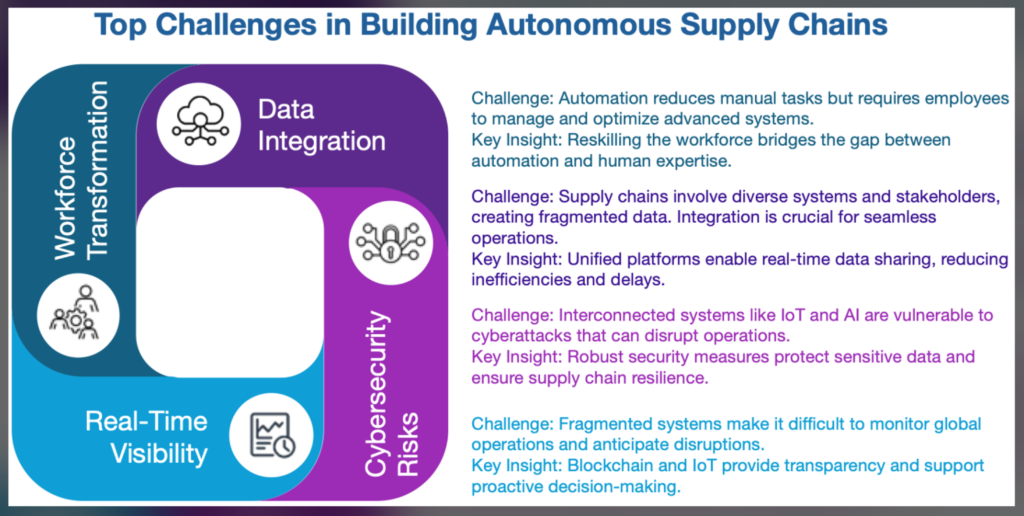
Despite these hurdles, businesses that address these challenges strategically can unlock the full potential of autonomous supply chains. From enhancing data integration to building a cybersecurity-first culture, these steps pave the way for resilience and innovation in logistics.
E. The Future of Autonomous Supply Chains
As businesses continue to invest in autonomy, the future of supply chains promises to be defined by unprecedented levels of efficiency, connectivity, and adaptability. Emerging technologies and evolving business models will push the boundaries of what autonomous supply chains can achieve, shaping an era where logistics operates with minimal human intervention. This transformation will be driven by advancements in AI, digital twins, blockchain, and autonomous vehicles, among other innovations.
- AI-Powered Demand Forecasting and Proactive Decision-Making
Artificial intelligence will play an even greater role in future supply chains by moving beyond reactive problem-solving to fully proactive decision-making. Future AI systems will not only anticipate disruptions but also simulate multiple scenarios and execute the optimal response without human oversight.
- Trend: Advanced AI algorithms will incorporate machine learning, natural language processing, and real-time market analytics to predict shifts in consumer behavior with remarkable accuracy.
- Example: A retail company might use AI-powered platforms to anticipate spikes in demand for specific products during unforeseen events, such as natural disasters, and automatically adjust production schedules and inventory levels.
- Digital Twins for Supply Chain Resilience
Digital twin technology is emerging as a game-changer, enabling companies to create virtual replicas of their supply chains. These models simulate real-world conditions, providing businesses with the ability to test various scenarios, identify vulnerabilities, and optimize processes before implementing changes in the physical supply chain.
- Trend: As the technology matures, digital twins will offer end-to-end visibility into supply chain performance, helping businesses address challenges such as bottlenecks, resource allocation, and sustainability goals.
- Example: A global automotive manufacturer might use a digital twin to simulate disruptions in its supply chain caused by semiconductor shortages, enabling it to optimize procurement and production strategies.
- Autonomous Vehicles and Drones for Last-Mile Delivery
Autonomous vehicles and drones are set to revolutionize the logistics industry, especially in the area of last-mile delivery, a segment that is notoriously costly and complex. With advancements in sensor technology, AI navigation systems, and regulatory frameworks, autonomous delivery is expected to become mainstream.
- Trend: Autonomous delivery solutions will reduce costs, minimize delivery times, and expand accessibility to rural and underserved areas.
- Example: Companies such as UPS and DHL have already piloted drone delivery programs, and Tesla’s autonomous trucks are positioned to disrupt long-haul logistics.
- Blockchain for Supply Chain Transparency and Trust
Blockchain technology is expected to play a critical role in addressing transparency and trust issues across global supply chains. By creating an immutable and decentralized ledger of transactions, blockchain ensures accountability and traceability at every step of the supply chain.
- Trend: Blockchain adoption will expand beyond food safety into sectors such as pharmaceuticals, electronics, and fashion, where traceability is critical.
- Example: A pharmaceutical company could use blockchain to authenticate and track vaccines, ensuring compliance with stringent regulations while building trust with consumers.
- Sustainability and Circular Supply Chains
As environmental concerns continue to influence business priorities, autonomous supply chains will integrate sustainability as a core function. Circular supply chains, where materials are reused, recycled, or refurbished, will gain prominence, supported by AI, IoT, and advanced analytics.
- Trend: Technologies will be used to monitor environmental impact, reduce waste, and optimize energy consumption throughout the supply chain lifecycle.
- Example: Companies like IKEA are investing in circular supply chain models, where AI and IoT track the lifecycle of materials to ensure maximum reuse and minimal waste.
What Lies Ahead
The evolution of autonomous supply chains will require businesses to not only adopt new technologies but also reimagine their operating models and partnerships. Collaboration between companies, technology providers, and regulatory bodies will be essential to unlock the full potential of autonomy.
As technologies like AI, blockchain, and digital twins continue to mature, they will converge to create hyper-connected ecosystems that operate with unparalleled efficiency. Companies that embrace these changes will be well-positioned to meet the challenges of tomorrow, while those that delay risk being left behind in an increasingly competitive marketplace.
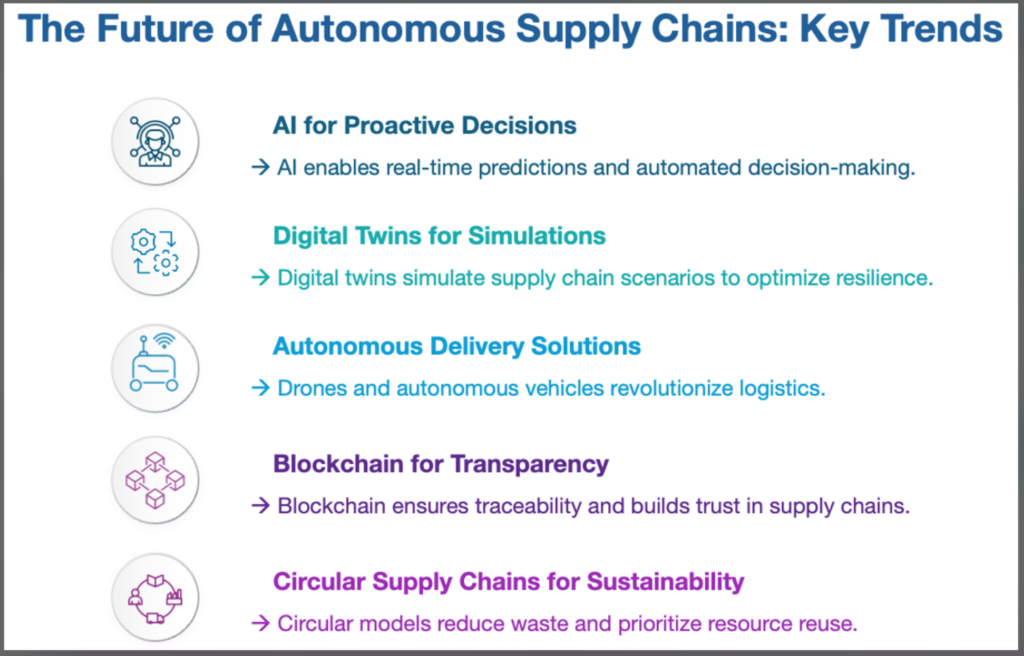
The future of autonomous supply chains is as exciting as it is transformative. By staying ahead of these trends, businesses can not only enhance their operations but also contribute to a more sustainable, transparent, and customer-centric world. The journey to full autonomy requires vision, investment, and collaboration, but for those who commit to the process and persist through its challenges, the rewards will be well worth the effort.
Conclusion: Embracing the Autonomous Future
The journey toward autonomous supply chains is not just a technological shift; it represents a fundamental transformation in how businesses operate in an increasingly complex and unpredictable world. From warehouse automation to predictive analytics and blockchain-enabled transparency, the innovations driving autonomous supply chains offer unprecedented opportunities for efficiency, resilience, and sustainability.
The real-world examples of Amazon, DHL, and Walmart demonstrate that autonomous supply chains are already making a measurable impact. These companies are reducing costs, improving delivery times, and enhancing customer satisfaction, all while laying the groundwork for even more transformative changes in the years ahead. However, this evolution is not without its challenges. Businesses must address barriers such as data integration, cybersecurity risks, and workforce transformation to unlock the full potential of autonomy.
Looking ahead, the future of supply chains will be defined by a convergence of advanced technologies. AI will continue to evolve, enabling proactive and self-optimizing decision-making. Digital twins will become essential tools for supply chain resilience, while autonomous vehicles and drones will redefine last-mile delivery. Blockchain will secure transparency and trust across global networks, and circular supply chains will align logistics with sustainability goals.
For businesses, the question is no longer whether to adopt autonomous supply chains, but how quickly and effectively they can do so. Early adopters will not only gain a competitive edge but also establish themselves as leaders in a rapidly evolving logistics ecosystem. Those who delay risk falling behind, unable to meet the demands of a fast-changing marketplace.
The path to autonomy requires vision, collaboration, and investment. It also demands a commitment to innovation and a willingness to embrace change. As businesses embark on this journey, they are not just optimizing their supply chains, they are reshaping the future of logistics for a smarter, more connected, and more sustainable world.
References
- Amazon Robotics Official Page. Available at: https://www.aboutamazon.com/robotics
- MIT Technology Review. “Inside Amazon’s Warehouse of the Future.” Available at: https://www.technologyreview.com
- McKinsey & Company. “Amazon’s AI-enabled Supply Chain.” Available at: https://www.mckinsey.com
- Forbes. “How AI is Revolutionizing E-Commerce Logistics.” Available at: https://www.forbes.com
- DHL Innovation Center. “Resilience360 and Predictive Analytics in Logistics.” Available at: https://www.dhl.com/global-en/home/insights-and-innovation.html
- IndustryWeek. “Predictive Supply Chains: DHL’s Data-Driven Approach.” Available at: https://www.industryweek.com
- DHL Parcelcopter Case Study. Available at: https://www.dhl.com/global-en/home/press/press-archive/2018/dhl-parcelcopter-logistics.html
- BBC News. “DHL’s Drone Delivery Breakthrough.” Available at: https://www.bbc.com
- Harvard Business Review. “Walmart’s IoT Strategy in Logistics.” Available at: https://hbr.org
- Business Insider. “Walmart’s Use of IoT for Real-Time Supply Chain Visibility.” Available at: https://www.businessinsider.com
- IBM Food Trust Blockchain Case Study. Available at: https://www.ibm.com/blockchain/solutions/food-trust
- MIT Sloan Management Review. “Blockchain in Retail: Walmart’s Food Traceability Project.” Available at: https://sloanreview.mit.edu
- Gartner. “AI’s Expanding Role in Supply Chain Optimization.” Available at: https://www.gartner.com
- World Economic Forum. “AI’s Impact on Global Supply Chains.” Available at: https://www.weforum.org
- GE Digital. “Digital Twin Applications in Supply Chains.” Available at: https://www.ge.com/digital
- Siemens. “Digital Twins in Industrial Operations.” Available at: https://www.siemens.com
- Tesla. “Autonomous Trucking and Logistics.” Available at: https://www.tesla.com
- Reuters. “Autonomous Vehicles Disrupting Logistics.” Available at: https://www.reuters.com
- IBM Blockchain. “Blockchain Solutions for Supply Chain.” Available at: https://www.ibm.com/blockchain
- World Economic Forum. “Blockchain in Supply Chains: Building Trust.” Available at: https://www.weforum.org
- World Economic Forum. “Circular Economy in Supply Chain Innovation.” Available at: https://www.weforum.org
- IKEA Sustainability. “IKEA Case Studies on Circular Supply Chains.” Available at: https://www.ikea.com/sustainability
